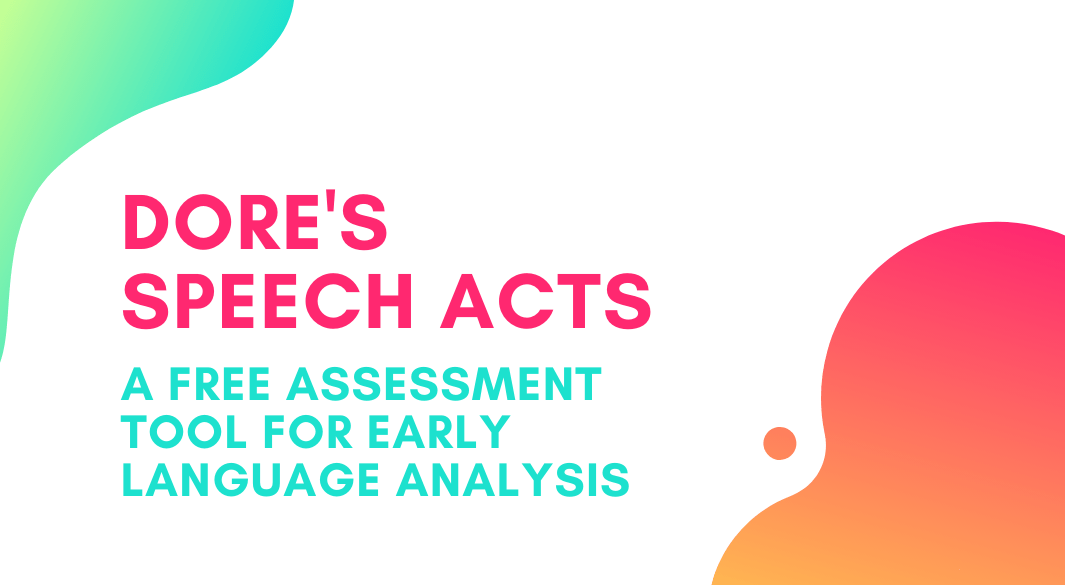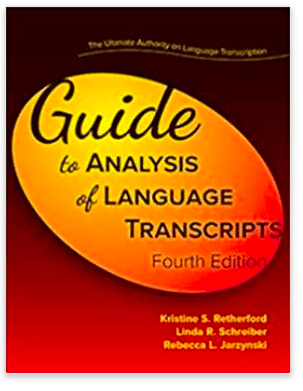Originally referred to as Dore’s Primitive Speech Acts, this simple taxonomy (or naming system) is a useful, evidence-based tool for analyzing pragmatic language in young children.
What is it for exactly?
Dore’s Taxonomy helps describe the intention of an utterance, consisting of a single word or a single prosodic pattern, before a child acquires sentences which can be subjected to other forms of analysis. It helps clinicians describe the communicative intentions observed in the language sample of a young child who is speaking mostly in single words.
Using a consistent taxonomy like this one helps professionals to communicate seamlessly and consistently. It is even helpful to identify and track intervention targets.
How do I use it?
- First, obtain and transcribe a language sample and/or conduct an observation.
- Review each of the child’s utterances and consider the following:
- The utterance
- Child’s nonlinguistic behavior
- Adult’s Response
- Relevant Contextual Features
- Based on the above, classify each utterance into one of nine taxonomical categories.
- The data can then be used to describe strengths and weakness or to inform intervention.
Where does it come from?
The taxonomy was developed in a series of research studies conducted in the early 1970’s, including two published studies:
- A Development Theory of Speech Act Production by John Dore, published 1973 in Transactions in the New York Academy of Science , Volume 35, Issue 8, Series II pages 623-630
- A Pragmatic Description of Early Language Development by John Dore, published in 1974 in the Journal of Psycholinguistic Research, Volume 3, Number 5
The studies looked at early language acquisition and development and perlocutionary and illocutionary force of utterances. Dore looked at two extensive language samples taken in 30-45 minute sessions every 2 weeks over several months.
The subjects were two children, one male and one female, both beginning at age 1:3. The samples were analyzed and “primitive speech acts” were isolated.
Dore’s operational definition of “speech act” is “an utterance, consisting formally of a single word or a single prosodic pattern, with functions to convey the child’s intention.” (Dore, 1974).
Four types of behavioral data were considered
- The child’s utterance
- Nonlinguistic behavior (e.g, gesture, facial expression)
- The adult’s response (verbal & nonverbal)
- Relevant contextual information (e.g., objects, locations, proxemics).
Based on these 4 observational criteria, all the speech acts were classified into nine categories which later came to be known as “Dore’s Primitive Speech Acts” or herein “Dore’s Taxonomy.” Dore himself points out in the original study that this list is not exhaustive.
What other evidence base is there?
- Pragmatic Functions of Toddlers Who Are Late Talkers by Michelle MacRoy-Higgins, and Ilana Kaufman published in Communication Disorders Quarterly, volume 33.
This study analyzed spontaneous language samples of 10 late talking toddlers and 11 typically developing toddlers using Dore’s primitive speech act analysis (1974). Late talkers did not produce as many pragmatic functions, and the ones that they do produce did not prompt continued interaction with a communication partner.
- Guide to Analysis of Language Transcripts – Fourth Edition by Kristine Retherford, Linda Schreiber, and Rebecca Jarzynski published by ProEd Inc. in 2019
This textbook is the authority on language transcription and analysis. It contains an even more detailed system for coding and analyzing conversational acts based on Dore’s primitive speech acts.
What are Dore’s Nine Categories
- Labeling: Uses a word(s) to indicate object or event while attending to it. Does not require a response from the adult or examiner present.
- Repeating: Repeats all or part of an adult’s utterance(s) but does not wait for a response from the adult.
- Answering: Answers adult’s question or address adult.
- Requesting (action): Addresses adult with word or appropriate gesture signaling demand. Waits for adult’s response.
- Requesting (answer): Asks a question of the adult with words or sometimes gestures. Waits for adult’s response.
- Calling: Calls for an adult/attention loudly and waits for response.
- Greeting: Responds appropriately to the appearance or disappearance of adult or examiner. For example, says “Hi” or “Bye-Bye.”
- Protesting: Addresses adult and resists adult’s action(s) with words or cry.
- Practicing: The use of prosodic patterns or words in the absence of a specific event or object. Does not address adult or require a response from adult.
Where Can I Learn More?
Apart from reading the original studies, the textbook Guide to Analysis of Language Transcripts – Fourth Edition by Kristine Retherford, Linda Schreiber, and Rebecca Jarzynski is a great source to learn more in depth about Dore’s taxonomy as well as other great tools.
My FREE Tool on TeachersPayTeachers
I’ve put together a quick reference tool to start using Dore’s taxonomy available for free through TeachersPayTeachers.
The download includes
- A 2-page pdf summarizing what you read here
- A 1-page reference table, re-created from the original study
- A brief example report using the taxonomy






